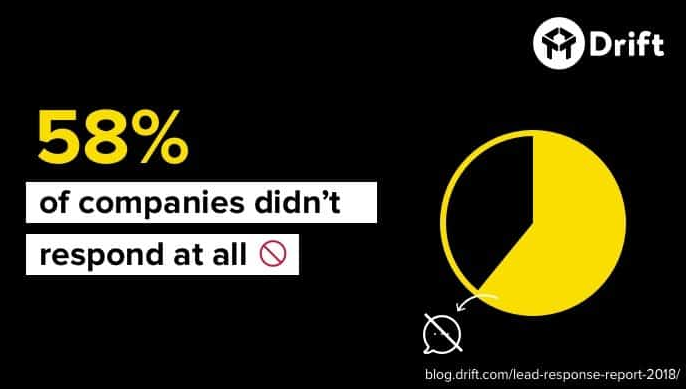Last week, I went to a fancy restaurant with one of those taster menus.
You know the kind — there are seven courses, but each one is one.single.bite.
A single, delicious, perfectly cooked bite — but still.
It's a little frustrating.
Seriously, I am hungry. Please feed me.
Here's the thing though — more isn't always better.
When you have to wait for that next perfect bite, you have time to sip your drink or talk to your friends.
Then that perfectly plated dish arrives — and it's worth the wait.
The same applies to leads —- quality is more important than quantity.
Everyone wants to generate more leads, but sometimes it's about more about how you nurture your leads rather than how many you get.
Would you rather get 25 mediocre leads and chase them all down — or five solid leads that you can nurture into paying customers?
So, rather than talking about how to get ALL THE LEADS, I want to talk about how to find the best leads — and then turn those perfect leads into paying customers.
Note: If you want to see how your lead nurturing tactics affect company behavior on your website, you can sign up and try Leadfeeder free for 14 days here.
6 best practices for B2B lead nurturing
Lead nurturing discussions tend to focus on lead generation tactics that every marketer knows: start with qualified leads, send promotional emails with discounts, advertise in search engines, etc.
What those tactics don't focus on is how to actually turn those leads into customers through lead nurturing.
Instead of focusing on worn-out tactics, we're talking about lead nurturing tactics like:
How to follow up fast
Use account-based marketing
Making the most out of email automation
Scoring your leads
Stay connected
Retargeting
Ready? Let's do this.
Follow up fast
Here's the thing — prospects go cold fast.
Really fast.
If you want to turn leads into customers, you've got to have a need for speed.
But how fast?
Several years ago, Dr. James Oldroyd reported:
“The odds of the lead entering the sales process, or becoming qualified, are 21 times greater when contacted within five minutes versus 30 minutes after the lead was submitted.”
That 5 minute stat has been a mainstay of sales training for years. It's been cited by a plethora of sites, including Hubspot.
You'd think folks would have gotten it by now.
Yet, a 2018 study found that just 7 percent of B2B companies were responding to leads in five minutes or less — and more than half of companies didn't respond to leads at all.

Which is just plain sad.
But, what happens when you don't have a 24/7 support team that can follow up on leads at 1 a.m.?
You don't need a bigger budget; you need technology.
Tools like CRM, email automation, or live chats lets you create customized rules that follow up for you and get the lead nurturing started — even while you are fast asleep. 🙌
Get personal with account-based marketing
ABM is about working smarter, not harder by targeting a few, strategic accounts instead of generating as many leads as possible.
Since you’re only targeting a small set of accounts, you can’t afford to throw a bunch of tactics at the wall and hope for the best.
That’s why understanding the journey companies take from brand-new-lead to conversion is so important.
When you see and understand how that journey works, you can tweak your approach to speed it up and identify behavior that typically leads to conversion.
That means you need to know as much as possible about your customer, including:
Buyer personas, including the job titles and roles who make the buying decision
Where companies come from before they find you
How they interact with your content and how long they spend on it
Where it leads them
EXAMPLE:
Leverage email automation
"But Anna," you think. "I am already using email automation."
But are you using it to its full potential?
For starters, you can use email automation to follow up on leads fast, as I mentioned above.
But, you can also create an entire drip campaign that guides your leads through from that first touch to qualification.
Granted, this won't work for every single client — but it can reduce the time required to qualify a lead.
Say, for example, you get a new lead on your website. Then what happens?
Do they wait for a sales call?
What if they aren't ready for the sales call yet?
Instead of wasting everyone's time, you can use a segmented drip campaign that sends them relevant emails about topics they have indicated interest on and — you guessed it — nurtures those folks until they are ready for a deeper connection.
Keep in mind that email automation can also give you a false sense of connection.
Email automation should be the first step towards building a stronger connection — not a fully automated, hands-off process.
Sidebar: When customers integrate Leadfeeder with MailChimp, they not only see the "companies" that visit their site but the "people" that visit their site. This is the ONLY way Leadfeeder users can get person-level data — and it is incredibly valuable.
Score your leads
If you use lead generation software to find leads, you may have noticed something about those leads.
Not all leads are created equal.
Scoring your leads allows you to focus more on high-value or very interested leads first, which will help you see more results — and helps you hit that 5-minute contact stat we talked about earlier much faster.
So how do you score leads?
Start with your CRM.
Look for clients who earn you the most money or take the least amount of time to get from that first contact to a closed deal.
Those clients are the most valuable.
Then, look for what those people have in common.
At Leadfeeder, we look at the size of the company — usually mid to large companies are our best clients.
But we also look at growth — companies that are growing fast tend to find our software really valuable.
You'll also want to look at:
Vertical or industry
Common pain points
How do they find you — PPC ads, social, referrals?
Once you have a solid understanding of who your most valuable customers are, you can focus more time and energy on those prospects.
Stay connected
When we talk about nurturing, a lot of times people think of taking prospective customers from that first touch to the last sale.
But nurturing doesn’t just work at the beginning of a relationship.
Sometimes it's about picking up where you've left off and reigniting the relationship.
Say, for example, you have a good friend who you haven't talked to in a few months. Life gets busy, right?
You realize that you've let your relationship flounder, so you reach out to catch up.
The same strategy works for lead nurturing.
Send an email to dormant subscribers to ask if they still want to hear from you.
Mention any new incentives or features they might be interested in, then offer a discount or other item of value as an act of generosity.
This type of email can work wonders when your customer or prospect has forgotten you exist.
Remind those people about what they loved about your business or product in the first place and bring them back into the fold.
Retargeting
If you want to get the best bang for your marketing buck, there is no better marketing strategy than retargeting.
Retargeting sends ads to people who have already indicated they are interested in your company.
Maybe they visited your website, bought a lower level product, or downloaded gated content.
They know who you are — so you already have a foot in the door.
In fact, customers who are retargeted with display ads are 70% more likely to convert.
With Leadfeeder, for example, you can create a custom feed that filters for the most engaged leads and retarget people who have viewed your website, engaged with content like white papers, or interacted with social media posts.
If they have interacted with you already, you know there’s some level of interest there.
That means the resulting feed of companies are highly-engaged. They’re the leads you want to spend budget and effort nurturing—because they’re most likely to ultimately convert.
Final thoughts
Generating new leads should be a core part of your B2B marketing strategy — but it is just one part of the puzzle.
Stop focusing on "more is better" mindset.
It is far more effective to use personalized data and technology to nurture better quality leads and, ultimately, turn those higher quality leads into paying customers.
Note: If you want to see how your lead nurturing tactics affect company behavior on your website, you can sign up and try Leadfeeder free for 14 days here.
Now that you're here
Leadfeeder is a tool that shows you companies that visit your website. Leadfeeder generates new leads, offers insight on your customers and can help you increase your marketing ROI.
If you liked this blog post, you'll probably love Leadfeeder, too.
Sign up







